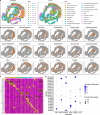This is a preprint.
TransST: Transfer Learning Embedded Spatial Factor Modeling of Spatial Transcriptomics Data
- PMID: 40321945
- PMCID: PMC12047910
TransST: Transfer Learning Embedded Spatial Factor Modeling of Spatial Transcriptomics Data
Update in
-
TransST: transfer learning embedded spatial factor modeling of spatial transcriptomics data.BMC Bioinformatics. 2025 Nov 6;26(1):274. doi: 10.1186/s12859-025-06099-z. BMC Bioinformatics. 2025. PMID: 41199193 Free PMC article.
Abstract
Background: Spatial transcriptomics have emerged as a powerful tool in biomedical research because of its ability to capture both the spatial contexts and abundance of the complete RNA transcript profile in organs of interest. However, limitations of the technology such as the relatively low resolution and comparatively insufficient sequencing depth make it difficult to reliably extract real biological signals from these data. To alleviate this challenge, we propose a novel transfer learning framework, referred to as TransST, to adaptively leverage the cell-labeled information from external sources in inferring cell-level heterogeneity of a target spatial transcriptomics data.
Results: Applications in several real studies as well as a number of simulation settings show that our approach significantly improves existing techniques. For example, in the breast cancer study, TransST successfully identifies five biologically meaningful cell clusters, including the two subgroups of cancer in situ and invasive cancer; in addition, only TransST is able to separate the adipose tissues from the connective issues among all the studied methods.
Conclusions: In summary, the proposed method TransST is both effective and robust in identifying cell subclusters and detecting corresponding driving biomarkers in spatial transcriptomics data.
Keywords: Clustering; Markov random field; Spatial transcriptomics; Transfer learning; factor model.
Conflict of interest statement
Competing interests: The authors declare that they have no competing interests.
Figures







References
-
- Hu J., Li X., Coleman K., Schroeder A., Ma N., Irwin D.J., Lee E.B., Shinohara R.T., Li M.: Spagcn: Integrating gene expression, spatial location and histology to identify spatial domains and spatially variable genes by graph convolutional network. Nature Methods 18(11), 1342–1351 (2021) - PubMed
Publication types
Grants and funding
LinkOut - more resources
Full Text Sources
